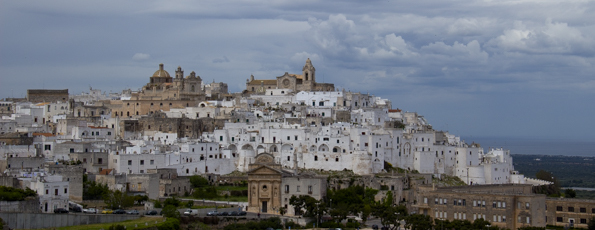
The view of Ostuni from the railway station was stunning, white buildings crouched on top of a hill. But – it was five kilometres away. I had walked past the local bus that meets every train because it was so small I thought it was a private mini-bus. There was only one option so I set off on foot. I had only been walking for a few minutes when a woman in her car stopped beside and I was asked if I would like a ‘passaggio’ (a lift). I accepted and we were soon speeding towards the town.
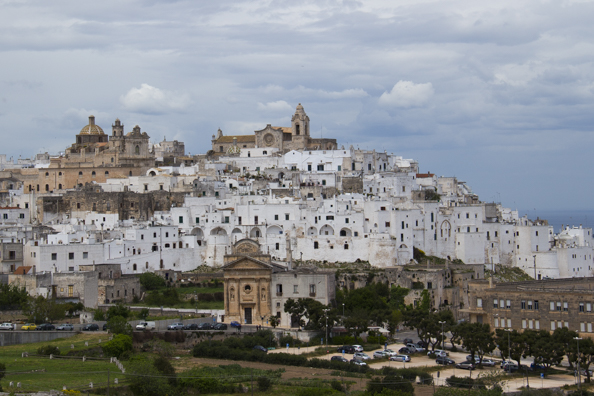
The directions I had been given to the old town were delightfully vague so I set off down the road and then asked for directions from a local who sent me round the back of the church of Maria Annunziata . Here I found the Post Office housed in the cloisters but there was no sign of an old town.
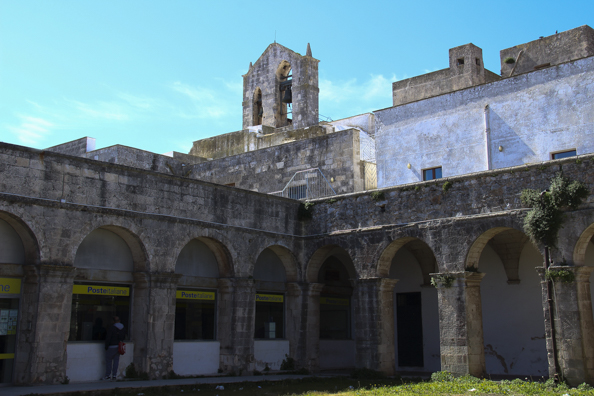
I tried again and this time I was directed down a narrow street that went downhill all the way to the Piazza della Libertà which is on the verge of the old town. This square is dominated by the Palazzo Municipale , originally the Franciscan convent of the Church of San Francisco d’Assisi and built in 1304. In 1739 the building was modified and then in 1864 it was enlarged, given a neoclassic facade and became the Town Hall. It also houses the Tourist Information office.
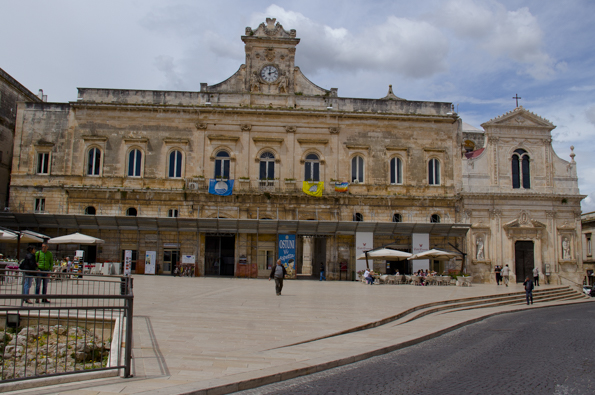
The impressive Column of Sant’ Oronzo towers above the Piazza della Libertà and archaeological diggings tunnel under it – all under the watchful eye of Sant’ Oronzo whose statue stands on the top of the Baroque style column which was built in 1771. This column was erected as an act of devotion to the saint who had protected the town from plague and famine during the same century. The excavations revealed the foundations of one of the main towers of the old city walls. The walls themselves were demolished during the seventeenth century to make room for an expanding population.

As I left the square the open door of the Church of San Francisco d’Assisi tempted me inside and there I found some exquisite stained glass windows.

I entered the old town and made my way up the hill to the Piazza Trincera where I found the cathedral but it was full of workmen so I moved on to admire the lovely arched loggia that links the Palazzo Vescovile to the Palazzoo del Seminario. The remains of the castle built in 1148 and destroyed in 1559 are inside the palazzo

From the piazza I followed a narrow alleyway that took me below the cathedral and onto the Viale Oronzo Quaranta a wide promenade that circles the old town. From there I could see some remains of the old city walls now embedded in some of the newer building – all white.


I walked all the way around the outside of the old town and then made my way back to the Piazza Libertà meandering through alleyways and up and down narrow flights of stairs admiring the old front doors and a variety of plants standing sentinel beside them. Sometimes they opened out onto a terrace overlooking the surrounding countryside.
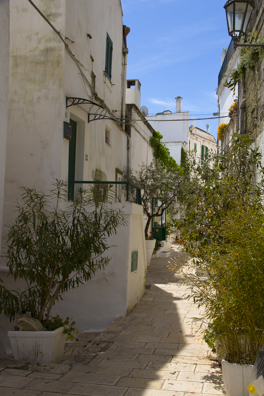

I went into the Tourist Information Centre to enquire about buses back to the station and was told there was an hourly service that stopped outside the tobacconist on the other side of the square – and the timetable was on the wall of that shop and tickets could be purchased inside the shop. I asked if there were any other sights I should see and was directed to the public gardens and the Hotel Ostuni Palace which has a terrace bar with a good view of the old town. I found the gardens which were lovely with the blossom on the trees but I struggled to find the hotel (probably because I was holding the map upside down). I requested directions from a local business man and, even though he was clearly in a hurry he took the time to lead me down a short cut through some narrow alleyways towards my objective. I was resigned to the requirement to buy an expensive drink I did not want in order to enjoy this special panorama when I came across a public terrace just below the hotel. I got some great shots of the old town from there.

I spent a long time taking photographs from every possible angel when a young man joined me on the terrace and asked me to take a photograph of him in front of the panorama. He was very specific about his requirements and even though I did not agree I complied and the images were recorded. When he offered to return the favour I climbed on to the iron railings and posed in front of my own camera. He liked my pose so much he requested, with a sheepish smile, more photos of himself in the same pose. Another poser had joined us by this time so I left him doing the honours and continued on my way. It had been a pleasant interlude – one of the joys of travelling.

*********************************************************************
Getting there
British Airways operates flights from London Gatwick to Bari and there are trains and buses from the airport to Bari Central railway station. From Bari Central there are regular trains to Ostuni. During my stay in Puglia I was based in Monopoli which is on the same line as Ostuni.
This article is now featured on GPSmyCity. To download this article for offline reading or travel directions to the attractions highlighted in this article, go to Walking Tours in Ostuni on GPSmyCity